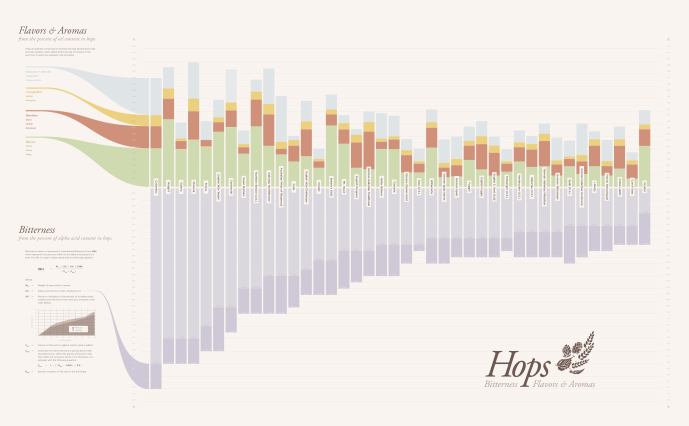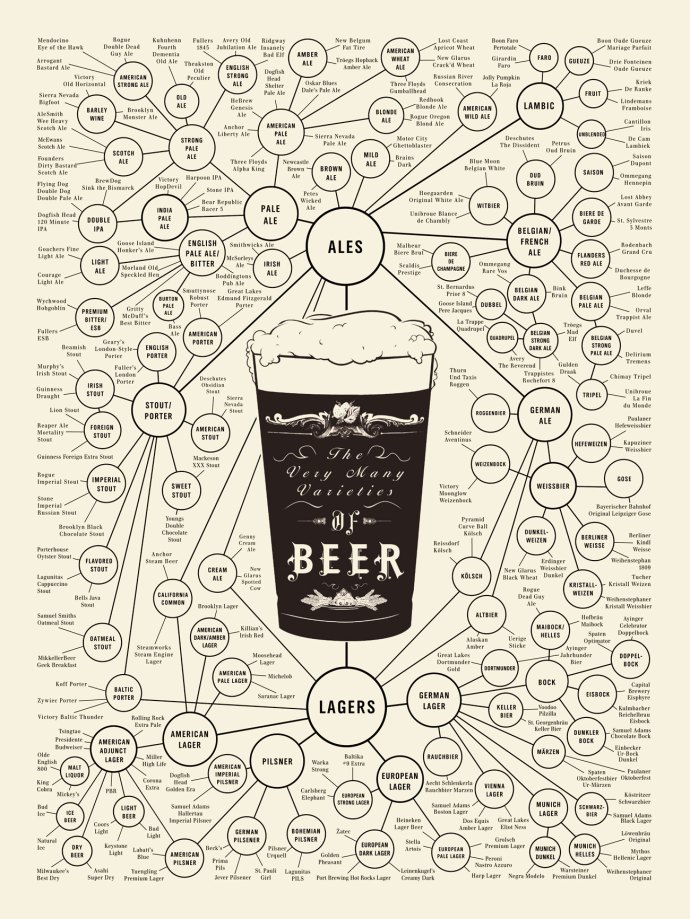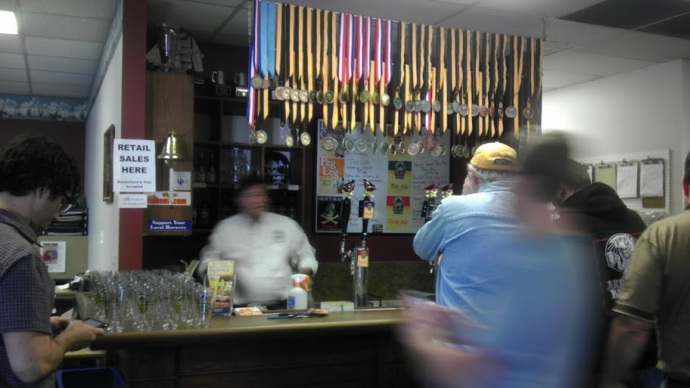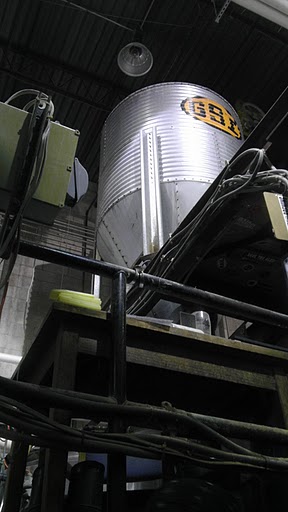Posts Tagged With: Beer Recipes
Local Vice: The Canton Brewing Co
Categories: Beer, Brew Pubs, Breweries
Tags: Ale, Alpha Acid, Beer, Beer Recipes, Brew Recipe, Brewing, Cleveland, Craft Beer, Hops, India Pale Ale, IPA, Learning How To Make Beer, Tony Bellatto
Leave a comment
What is an IPA? Infographic
The Story behind IPA is an interesting one. To understand IPA we first have to understand the hop, the rest will fall into place after we discuss the preservative nature of hops. Hops are composed of two major acids. Alpha Acid, and Beta Acid. Alpha acid is slightly responsible for preventing bacterial growth in the beer, such as bacteria that comes from lactic acid. Alpha acid is also responsible for adding the bitter component to beer. The beta acid does not add initial bitterness but does aid in the fermentation and aging of the beer adding the bitter components slowly over time. What does Alpha acid in hops have to do with IPA? Alcohol and hops(becuase of the alpha acid) preserve beer. Alcohol provides an unfavorable environment for microbial action, and the isohumulone content of the hops inhibits the growth of bacteria such as Lactobacillus. Thus, high alcohol content, in German export beers, for example, and high hopping rate, as in India pale ale, could protect beer from the souring associated with long storage times.
This brings forth another question, why do we need to preserve the beer anyway? The answer is simple. In the early 17th century there was beer, and a lot of it. A lot was in the form of Pale Ale, a term coined by the use of pale malt and back then a lot less bitter then the pale ales of today. The actual story is quite long so I’ll simplify it for you. George Hodgson of the Bow Brewery, on the Middlesex-Essex border, was the go-to guy for the East India Trading company for all their beer needs, be it exporting or consumption for British troops stationed in India. The East India Trading company noticed that Hodgson’s liberally hopped pale ale seemed to make the trip down around Africa a little bit better than the less hopped lower alcohol version of Pale Ale at the time. The trading company noticed this and asked him to up the ante, he did, and the well-preserved India Pale Ale was born. This is the most common story, however, doing a little digging I found that there may have been a little more politics in this history that we think. It turns out that the EITC chose the Bow brewery because of its location as well as his liberal credit terms, and that his October beer and Porter were also Highly in demand in India as well, which both seemed to survive the trip, according to record, quite well. So whats the real story? Who knows? What we do know is that hops add a lot of bitterness and help preserve the beer. I know I like the romance of it all, additionally I love the beer and I really love making it.
Categories: Beer, Beer Infographs, Breweries, Home Brewing, Reviews
Tags: Ale, Alpha Acid, Beer, Beer Recipes, Beta Acid, Brewing, Cigars In Review, Craft Beer, Home Brew, homebrew, Hops, India Pale Ale, Infographic, IPA, IPA infograph, Learning How To Make Beer, Tony Bellatto
4 Comments
Hops, IBU formulas, and Alpha Acid, Infograph style
This is a greeeat Infographic poster for those that are getting into homebrew, as well as for those that have been at it for a while. You can print it and put it in your la-bor-a-tory for reference while making your recipes and deciding what hops to use as well as were they stand on the bitterness scale. It also gives you origin and some notes on each varietal. Enjoy
Courtesy of Zeke Shore and Cork and Kegs
Categories: Beer, Beer Infographs, Home Brewing
Tags: Ale, Beer, Beer Infographic, Beer Infogrpah, Beer Recipes, Brew Recipe, Brewing, Brown Ale, Cigars In Review, Cleveland, Cork and Kegs, Craft Beer, Home Brew, homebrew, Hops, how to make beer, Infographic, Learning How To Make Beer, Sommelier, Tony Bellatto
Leave a comment
The Different Styles Of Beer, Infographic
Categories: Beer, Beer Infographs
Tags: Ale, Beer, Beer Infographic, Beer Infogrpah, Beer Recipes, Brewing, Craft Beer, Home Brew, homebrew, Hops, Infographic, Learning How To Make Beer, Tony Bellatto
Leave a comment
Heavy Seas and Dogfish Head Brewery Tours, Makin a Firkin, and other nonsense
Over the weekend I had the incredible opportunity to visit some amazing craft breweries in Balitmore and Milton. Dogfish Head, and Heavy Seas. In my opinion they make some of the best craft beer on the market, and this trip was really special and very informative, I got to dry hop a firkin at heavy seas, and learn about the whole firkin process, and its history as well as taste some special brew pub exclusives at Dogfish as well as tour their facility.


Heavy Seas was the Initial stop on my whirlwind tour of the East Coast. A small but very capable brewing company, that appreciates the old world styles of making and aging beer, they are very concerned about small production, barrel aging and new firkin program. They are very involved in CAMRA or the campaign for real ale. As taken from their website
“CAMRA campaigns for real ale, real pubs and consumer rights. We are an independent, voluntary organisation with over 100,000 members and have been described as the most successful consumer group in Europe. CAMRA promotes good-quality real ale and pubs, as well as acting as the consumer’s champion in relation to the UK and European beer and drinks industry. We aim to:
- Protect and improve consumer rights
- Promote quality, choice and value for money
- Support the public house as a focus of community life
- Campaign for greater appreciation of traditional beers, ciders and perries as part of our national heritage and culture
- Seek improvements in all licensed premises and throughout the brewing industry
CAMRA, the Campaign for Real Ale, is an independent, voluntary, consumer organisation which campaigns for real ale, real pubs and consumer rights.
Membership is open to all individuals although corporate entities such as breweries and pubs are not members; we currently have over 120,000 individual members.CAMRA is governed by a voluntary unpaid national executive, elected by the membership. We have a branch structure which means that all members can join a local CAMRA branch and campaign and socialise locally. There are around 200 branches covering the UK and many of the branches run local beer festivals, publish local newsletters and run social events to pubs and breweries.Although we are a volunteer-led organisation there is also a small professional staff of twenty five responsible for central campaigning, research, membership services, publishing, marketing and administration.CAMRA is financed through membership subscriptions, sales of products such as books and sweatshirts, and from the proceeds of beer festivals. We are a not-for-profit company, limited by guarantee and our accounts are lodged annually with Companies House.”
You can visit them at http://www.camra.org.uk/ I suggest you do !!!
Upon arrival we were welcomed by the owner with seasonal brew pub exclusives, including the Heavy Seas Golden Ale, and Davy Jones Lager

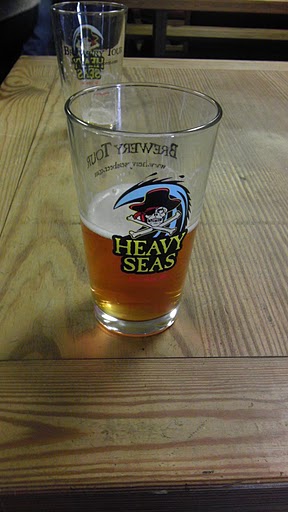 The Gold Ale was one of my favorites !Nice, rich, complex and refreshingApprox 4.5% ABVDeep gold in color with floral and spicy hop aromas. Brewed with pale, carmel, and Munich malts balanced with Cascade, Centennial and Hersbrucker hops. Well rounded, fruity and complex. Pairs well with salads, mild cheeses and pulled pork BBQ. 2010 GABF Medal Winner ~ 2010 Gold Award, World Beer Cup
The Gold Ale was one of my favorites !Nice, rich, complex and refreshingApprox 4.5% ABVDeep gold in color with floral and spicy hop aromas. Brewed with pale, carmel, and Munich malts balanced with Cascade, Centennial and Hersbrucker hops. Well rounded, fruity and complex. Pairs well with salads, mild cheeses and pulled pork BBQ. 2010 GABF Medal Winner ~ 2010 Gold Award, World Beer Cup
The Davy Jones Lager is a very interesting interpretation of a Lager. Spicy Its an imperial Lager, and moreover techincally a Cream Ale….Where you at Genny!!!!
Approx. 7% ABV
Fermented using lager yeast at ‘ale’ temperatures then slowly lowered down to ‘lager’, taking the yeast from the top down to the depths of Davy Jones’ locker.
After those great brews We took the tour with a glass of Marzen in hand. The Marzen was a traditional amber lager brewed with German spirit with toasty malt and a sweeter finish, with some horseradish cheese this was definitly a winner.
After the tour we had a great East Coast lunch, and were delightfully informed that we would be learning the history of the firkin, and then dry hopping and filling our own firkins !!!
So, What the Firk is a Firkin?
Firkin : definition:
A firkin is an old English unit of volume. The name is derived from the Middle Dutch word vierdekijn, which means fourth, i.e. a quarter of a full-size barrel.
Nor need you mind the serial ordeal
Of being watched from forty cellar holes
As if by eye pairs out of forty firkins.
— Robert Frost, “Directive”
For beer and ale a firkin is equal to nine imperial gallons, seventy-two pints, or a quarter of a barrel (40.91481 litres). Casks in this size (themselves called firkins) are the most common container for cask ale. A firkin is equal to half a kilderkin.
For wine the firkin had a larger size, namely a third of a tun. A tun being 210 gallons in the UK and 252 fluid gallons in the US, thus a wine firkin is about 318 l (318.226 or 317.975). It is also called tertian or, preferably, puncheon (in the US also shortened to pon).
Butter and soap used to be sold by the firkin, too. In these cases it was a measure of weight, instead of volume: e.g., 56 lb(25.4 kg) and 64 lb (29.0 kg) respectively.
The term firkin is currently used to refer to antique wooden buckets, usually with wood handle and lid, about 10 inches (250 mm) high and 10 inches in diameter (about 10l or 2-3 dry gallons in capacity), formerly used to store sugar and other items.
The firkin (a firkin of water) is the base unit of mass in the humorous FFF System.
Basically a Firkin is a 9 gallon keg used to age beer, and also cask condition it. Cask condition meaning secondary fermentation takes place in the keg itself, and additionally it is desgined to pour and serve beer, without the use of additional Co2. This is part of the “campaign for real ale”, as this is the most ancient and first way of making beer prior to modern kegs.
Here is what we used…
10.5 gallons Heavy Seas Loose Cannon IPAB
3oz. Maryland Citra Hops
3oz. Maryland Pallisade Hops
2oz. Simcoe
a pinch of dried lemon, lime, and orange peel
2 stems of eucalyptus wood
a bushel of lemon basil
…. This Post will continue soon!!! check back for the conclusion!!!!!
Categories: Beer, Brew Pubs, Breweries, Home Brewing
Tags: aging beer, Ale, Alpha Acid, Baltimore, Beer, Beer Recipes, Beer Reviews, Brew Recipe, Brewing, Brown Ale, Cigars In Review, Cork and Kegs, Craft Beer, Dogfish, Dogfish Head, firkin, Heavy Seas, Home Brew, homebrew, Hops, how beer is made, India Pale Ale, IPA, Learning How To Make Beer, Maryland, Rehobeth Beach, Tony Bellatto
Leave a comment
…and yet another infographic
I Figured since the season was upon us, I should post this courtesy of http://www.fermentnation.com, great beer blog i just discovered . Going up to the coast this weekend, Look forward to a big post on Dogfish and Heavy Seas!!!!!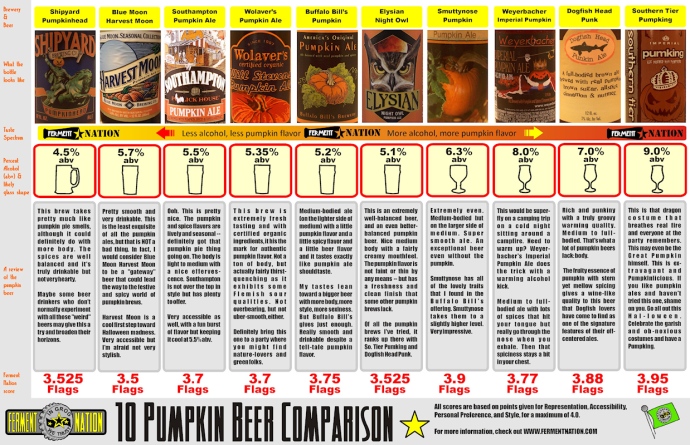
Another Good Craft Beer Infograph
Please visit http://www.homebrewersformulary.com/ and order a copy of this awesome Home Brewer poster !!!! Also, stay tuned for my trip to some great East Coast Breweries!!!
Here is a preview courtesy of Scott K James, creator of the poster
Categories: Beer, Beer Infographs
Tags: Ale, Alpha Acid, Beer, beer color, Beer Recipes, Brew Recipe, Brewing, Brown Ale, calculating bitterness, carbonation, Cigars In Review, Cork and Kegs, Craft Beer, Home Brew, homebrew, Hops, mash, mashing, Sommelier, Tony Bellatto, yeast
Leave a comment
Homebrew Cheat Sheet
I decided to start doing weekly infographs as i find them. This is a really good one on how to make beer Cheers ! -Tony
Categories: Beer Infographs
Tags: Ale, Beer Infogrpah, Beer Recipes, Brew Recipe, Cigars In Review, Cork and Kegs, Craft Beer, Home Brew, homebrew, Hops, Learning How To Make Beer, Tony Bellatto
Leave a comment
Our Brown Ale, Converting Alpha Acid’s to IBU’s, and a some great hops infographics
It seemed as if all the pieces came together for us and exactly the right times. I had just finished a brown ale brewed at Jan’s and now was ready to go on my own but i needed equipment and I needed it built. My good friend Justin and I were talking and he already had a bunch of materials that were ready for us to brew as he previously made wine. The only ting we really needed in terms of big things to start was a brew kettle and a wort chiller amongst other things that add up, Like Co2 , and Pepsi kegs. I wont even begin to talk about the adventure of the gauges just yet. Anyway we found an old Labbatt 15.5 gallon keg and Justin knew some hillbilly welders that build hotrods and trailers that knew how to weld. The price, free beer when we finish making it, now thats America!! The top of the Keg was plasma cut out and we put a j-valve near the bottom with a screen to filter out the hops.
In another streak of good luck, Justin, who works for a developing company got word that an apartment needed new kitchen fixtures and the old, steel, ones that were in perfect condition were just going to be thrown away, so….we volunteered to take them off of there hands for no cost.
For our first beer on our own I grabbed a good crew of guys, Bryan Infante (www.cigarsinreviewinfante.wordpress.com ) and a good friend of mine, Justin Cassagrande, who is our brewery designer and builder and, he really likes beer. I decided that I would try and redo the brown ale that won us the award. The reason why its an issue to duplicate is because the first one we did was on-the-fly as Jan was brewing a milk stout at the same time. I decided mid-brew that I wanted to use some of the lactose and some of the malt color from the milk stout to deepen the SRM and also to add the creamy sweetness of the lactose used in the Milk Stout, The only issue was i used about a gallon or less of the milk stout and I had no real idea how much more malt and how much lactose to actually add. When I designed the recipe for this one, in all honesty i “wung” it again but this time i wrote it down. The Recipe is as follows
Until Recently, I didn’t understand the concept of Alpha Acid and IBU’s and when they needed to be put in the beer and for how long but there is a pretty simple explanation and formula.
Looks Complicated doesn’t it ? Well it really isn’t, here we go
The AAU/HBU measurement of a hop addition is determined by multiplying the amount of hops by the hops’ alpha acid. While AAU/HBU formulas are quite simple and are still used in homebrewing, they have limited value in determining overall bitterness because they don’t factor in length of boil and other important parameters.
IBU calculations are just as simple, much more accurate, and are adaptable to a wider range of brewing situations. However, to be able to meaningfully incorporate IBU figures into brewing, you need to know and understand the basic IBU formula: IBU = Hops x AA% xutilization / volume x 1.34
- Hops = the weight of hops in ounces
- AA% = alpha acid percent
- Utilization = the utilization percent
- Volume = the volume of the final batch in gallons
- 1.34 = a constant to convert measurement into US standards
Now for the utilization
23@60 min
18@45 min
15@30 min
7@15 min
Technically speaking, utilization is
The final variable in the IBU formula is utilization percentage. In a perfect world it would be nice to assume that all of the potential bitterness available from the hops is extracted into the finished beer, but unfortunately that is not the case. Many factors affect the amount of bitterness actually liberated, or isomerized, into the finished product. Some of the more common factors:
Length of Boil: The longer the hops are boiled, the more bitterness is extracted into the finished beer. This is generally good up to about 90 minutes, at which point the law of diminishing returns takes effect and less bitterness is extracted per unit of time. Conversely, late hop additions for flavor or aroma will contribute considerably less bitterness due to the reduced amount of boil time.
Intensity of Boil: Homebrewers using a mega-BTU outdoor cooker can virtually blast the enamel off a steel pot and will have a much more vigorous or intense boil than the homebrewer using an electric range. The more intense and turbulent the boil, the more hop bitterness is extracted.
Volume of Boil: The greater the volume of wort being boiled, the more effective the extraction of hop bitterness will be. Don’t confuse this with final wort volume in the IBU formula. For brewers with smaller brewpots who can only do a partial wort boil, it is important to realize that the reduced volume of the boil will reduce the extraction of the hops.
Specific Gravity of Wort: Dense, high-gravity worts with lots of dissolved sugars will reduce the ability of the wort to extract alpha acids in the boil. The purchase of a large-volume brewpot (seven gallons or greater) and the attendant accessories such as a high-output burner is even more appealing when you consider that a reduced wort volume combined with the increased gravity associated with only boiling a portion of the batch and then later topping off to final volume is a double whammy against effective hop bitterness extraction.
Quality of Hops: Old or stale hops will lose some of their alpha acid value. Also, pellet hops usually provide a slightly greater degree of utilization in the boil than their whole leaf counterparts of equal alpha acid value.
Fermentation: The use of a small-volume fermenter and a blow-off tube for the early stages of fermentation will result in a portion of the hop resins being “blown off” with the foam from the kraeusen. In addition, as the yeast flocculates out it will carry with it some of the isomerized bittering compounds.
While there are many published sources that provide specific figures for each of these factors along with involved calculations, utilization percentage can be estimated fairly well. When doing a full-wort boil of moderate gravity (1.045 to 1.055), with hops boiled for 60 minutes or more, assume a utilization of 30 percent.
You can make a pretty good estimate of how your own brewing conditions will affect utilization and modify the numbers accordingly. For example if you are unable to do a full-wort boil or the beer you are making is of a relatively strong gravity, then it would probably be safe to assume that the estimate can be factored down by 2 percent to 3 percent.
I say forget all that and stick with my earlier estimations of utilization for the Home brewer they seem to be pretty spot on , and I have not ran into problems yet.
For Example using the Brown Ale recipe we used .5 oz of cascade at 30 minutes boil time at 6.6% AA lets figure out the IBUS (IBU = Hops x AA% x utilization/ volume x 1.34) IBU=(.5 x 6.6 x 23 /10 x 1.34) = ( 3.3 x 23 / 13.4) = (75.9/13.4 ) = 5.66 IBU’s @ 30 minutes boil time.
Using this formula is very useful in planning when and what to put into your brew according to BJCP guidelines.
This infographic is courtesy of Zeke Shore and corkandkegs.com Thanks guys for the wonderful work. This can be used as a guide to figuring out what hops and what AA you want in your next brew !!!



